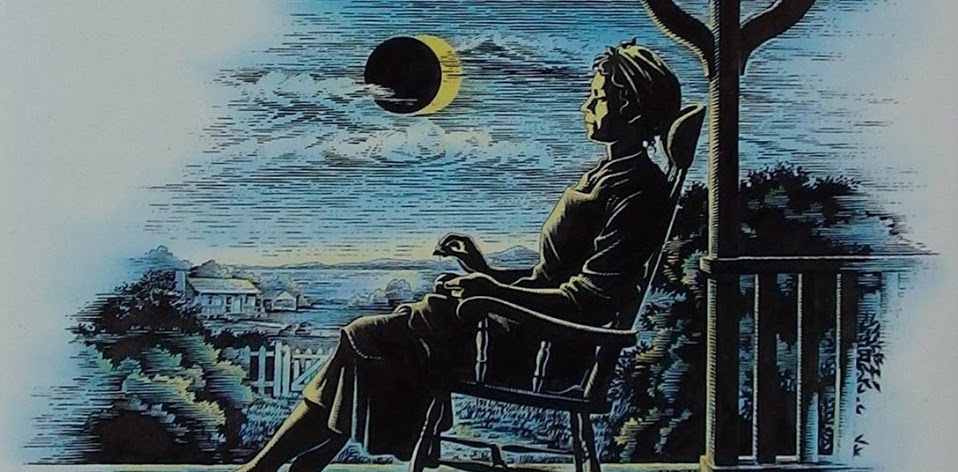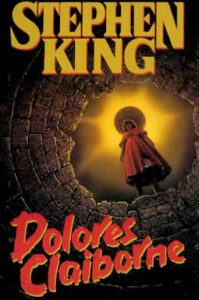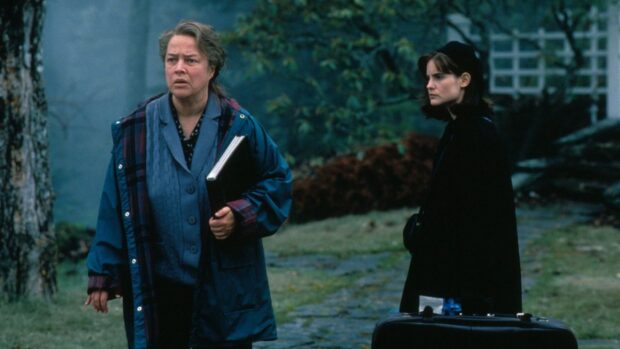Welcome back to the feature column that explores Stephen King’s books in the order they were published…sort of! A novel that may not dwell in the wells of traditional horror, but still manages to go to some dark places.
WARNING: this confession contains spoilers.
“What did you ask, Andy Bissette?” Just like that, the storyteller grabs the reader by the ears and holds them to attention. Structured as a monologue from the eponymous narrator to a policeman, it’s not so much a ‘whodunnit’ as a ‘whydunnit.’ It’s also one of Stephen King’s most complex character pieces.
Set in the fictional Maine town of Little Tall Island, DOLORES CLAIBORNE is a single continuous narrative. It’s a confessional, as the strong-willed 65-year-old narrator tells police chief Andy Bissette (and his stenographer) that she did not kill kill her elderly employer, Vera Donovan. She does, however, confess to the death of her husband decades earlier.
This unique structure, at least as far as King is concerned at this point in his career, is almost completely free of supernatural themes. It begins “in the middle” with Dolores describing her work for the elderly Vera. Dolores is convinced that the mostly incapacitated Vera has weaponised her bowel movements, while Vera is convinced she is seeing something she calls “the dust bunnies” coming for her.
Yet the core of the story is about Dolores, her husband Joe St. George and their daughter Selena. Joe St. George is what you would call a bad man: he drinks and he’s abusive. Dolores’ children are unaware of the abuse, and when she witnesses her mother retaliate by threatening Joe with a hatchet, she believes her mother is the aggressor. Joe uses this to divide mother and daughter, and takes advantage of the power dynamic to molest Selena.

So, while there are no literal monsters, King still manages to go to some dark places. King has often been at his darkest when he explores the evil that humans are capable of doing in The Shining, Misery, Rage to name a few. Indeed, in sister book Gerald’s Game, Jessie’s predicament triggers memories of abuse at the hands of her father. Dolores’ justified rage upon discovering Joe’s deeds results in one of the book’s best set-pieces: her premediated murder of Joe, attempting to dispose his body in a well. The ensuing misadventure, as the not-quite-dead Joe tries to get out, would be comical were it not so macabre. It is also a setup for the gripping final chapters, in which Vera’s death is not at Dolores’ hands but inescapably connected to a legacy of murder they were both involved with.
“When you’ve done a murder, you never know what may come back to haunt you later on.”

Abuse is not the only thing that links this to Gerald’s Game. “Both are tales of women in the path of the eclipse,” writes King in the DOLORES CLAIBORNE introduction, “and of how they emerge from the darkness.” Just as Jessie had visions of a woman kneeling in blackberry tangles, the key events described here open Dolores’ “inside eye” to visions of a young girl in trouble. Connected by the same solar eclipse, Dolores sees Jessie abused by her father, and later “all grown up…but she’s in terrible trouble.” It’s the closest King comes to the supernatural here, but it’s more about universal connectivity than metaphysics.
While Gerald’s Game doubles down on the supernatural ambiguity, and goes off in a different direction in the final act, King solidly sticks the landing in this companion novel. Reaching down in the accumulated guilt, betrayal, estrangement of a lifetime of protectiveness, it is a book that just as much about unconditional parenthood as it is about darkness. This arguably connects it more firmly to King’s oeuvre than anything else.
Like many of King’s works, it’s also enjoyed multiple lives outside of its print origins. In addition to Taylor Hackford’s well-received film adaptation in 1995, reuniting Misery‘s Kathy Bates with King’s source material, it’s been the basis for both a stage play and an opera. Even Little Tall Island got revisited in Storm of the Century, an original TV miniseries written by King. Take that Children of the Corn. The audiobook version, read by Frances Sternhagen (best known for Cheers and her stage career) is phenomenally good. Her forceful monologue and New England drawl may be the best case for the audio being the superior experience.
“The trouble with bein’ innocent,” concludes Dolores “is you’re more or less stuck with the truth.” The truth about DOLORES CLAIBORNE is that it’s very good, and arguably one of the best non-horror King novels out there. It’s a dialogue between the speaker and her audience, one that makes us part of the story by complicity. While it stands alone as its own mystery, it also takes on a whole new context when viewed as a twin with Gerald’s Game. It’s essential King – but only if you’re willing to listen.
Next time, Inconstant Reader hits up 1993’s Nightmares & Dreamscapes, a massive collection of short stories. In the meantime, we’ll also check out King’s first 2021 release, Later. While you’re here, go check out Batrock.net, where my buddy Alex Doenau is running through this Stephen King adventure with me.






